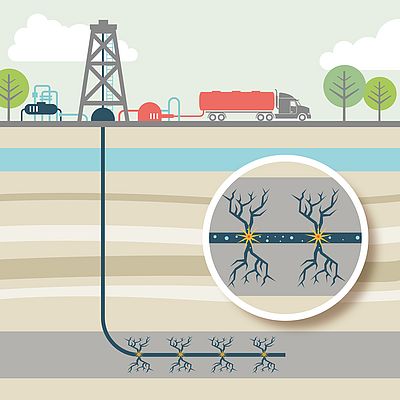One of the most common forms of unconventional energy sources, shale gas is also a subject that polarizes opinions across the world. Broadly speaking, most Americans love it, Europeans don’t and the Asians will decide how they feel once they can get to it.
Shale gas refers to the fluid that is held in shale rock. Because it is difficult to obtain this fluid by orthodox methods, the rock must be fractured hydraulically to release the fluid—a process commonly known as “fracking.” The process, from extraction to custody transfer, offers great opportunities for the makers of flowmeters and other process instrumentation, as it is necessary to measure flow characteristics at certain points.
Extracting the gas
When a reserve has been found, the first stage of the extraction process is to pump water into the well to release the trapped gas. Magnetic flowmeters generally are used for this application because of their suitability in working with conductive liquid media and also because their cost is low relative to the application. After the fracking process, a well is then drilled and depressurized, allowing the gas to flow out of the shale and into the well.
Non-contact measuring technologies such as ultrasonic, Coriolis and thermal mass meters are used to measure the extracted gas. It is no coincidence that revenues for these three meter types are forecast to grow the fastest worldwide during the next five years—up by 13.1%, 12.4% and 8.7%, respectively, for every year. As these highly accurate meter types have no moving parts and use non-contact measuring principles, they are subject to relatively little wear and tear, and so require minimal repair and maintenance.
Multiphase flow-measurement
The fluid extracted from shale wells contains multiple components in its stream of liquid with the gas entrained or suspended. To measure the individual components presents a challenge, which is why multiphase flow measurement systems are needed. Currently the most common form of measuring multiphase flow streams is by using separators. These isolate the gas phases from the liquid(s), which are then measured independently to determine the characteristics of the different fluids.
At the time of writing for this article, many manufacturers were undertaking research and development to produce a technology that could measure multiple phases of flow using minimal separation stages. New developments have also resulted in Coriolis meters that possess dual-phase measuring capabilities, measuring two phases of fluid, oil and gas. However, the problem arises where there is entrained gas, which becomes difficult to measure. Coriolis flowmeters have the added advantages of being cheaper to recalibrate and maintain, since they lack moving parts.
Custody transfer
During the whole process and depending on the geographic region, the fluid passes through the hands of many different parties across the supply chain. Custody transfer refers to the transfer of fluids from one party to another. The supply chain of the process industries commonly involves the transfer of raw materials into plants via various modes of transportation.
The need to measure the raw materials accurately is vital because payment is based on the volume or mass transferred from one party to another. When it comes to industries such as oil and gas, or chemicals, a small error of less than 1% can cost a business millions of dollars per year, especially as the value of these commodities has been rising steadily. Demand for accuracy is high, and it is not unusual for metering to have an accuracy of +/- 0.1% for fluid transfer. Although many flowmeter technologies are suited to this application, it is widely accepted that Coriolis and ultrasonic meters are the benchmark.
Shale gas exploration
With shale gas extraction booming in North America for a number of years, it now accounts for 35% of natural gas produced in the United State. This is forecast to increase to 50% by 2040, according to the Energy Information Administration (EIA).
To be sure, the concept of fracking is ostensibly more acceptable in the United States than in Europe. There are many explanations for this—many Americans are less concerned about catastrophic global warming than about securing cheap fuel supplies; are more accepting of new technologies; and perhaps are less concerned about safety incidents in regions of relatively low-population density.
It must also be noted that the majority of fracking activity in the US tends to occur on private land, and therefore the government is not usually involved. In places like Saudi Arabia, all of the oil extracted belongs to the state; hence, there is a lot less metering as there are fewer custody transfers.
China, for its part, contains twice the shale gas reserves of the United States. What hinders the exploration and extraction of shale gas in China at the moment is its state-controlled oil and gas industry structure and the networking infrastructure in China. Currently 90% of its pipelines are owned by CNPC, which is unlikely to want to facilitate transportation for its rivals. IHS CERA predicts that it will be well into the 2020s before shale gas becomes an important domestic resource.
Impact of public opinion
There is little doubt that shale gas will help boost the sales of flowmeters in the future. With the fluid that is extracted from the ground, measuring devices are needed that can provide highly accurate meter readings, which is even more important given rising energy prices. In the future, many manufacturers believe that Coriolis flowmeters will continue to be used in dual-phase flow measurements as they are now.
To this end, a single device that can make more than two measurements is unlikely, as it is difficult to measure liquids and gases simultaneously. A much more likely scenario is that, as technology and manufacturing techniques improve, the cost of multiphase measuring solutions will fall and they will become more accurate. Accuracy will be an essential requirement as production will start to occur in deeper locations.
Apart from North America, the rest of the world still appears hesitant about the idea of fracking for a variety of environmental and political reasons. Nonetheless, there are signs that public perceptions are easing slightly and that governments around the world—clearly warming to the idea—are initiating fracking operations.
All told, the success of the flowmeter application for shale gas will depend on the ability of large oil and gas companies to effectively address and deal with public opposition. If such barriers are overcome, the flowmeter market within the unconventional oil and gas market is set to become rock-solid.
By Kiran Patel, IHS Inc.


















